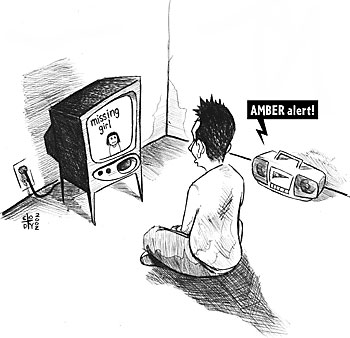
Illustration by Cody Angell
|
By Jason Baran
Arizona Daily Wildcat
Monday November 25, 2002
What could be so important as to interrupt college football on Rivalry week?
A kidnapped child.
On Saturday morning, a male ÷ not man, because man carries connotations of responsibility and adult behavior ÷ drove to his daughter's house and took her. So what? Well, he just happened to lose custody rights after he was sent up the river for years because he couldn't keep from stealing. Apparently, four years wasn't enough; he didn't learn his lesson.
The authorities were notified and they called in the cavalry. The cavalry is the five million people that call Arizona home. This past September, Arizona initiated the statewide Child Abduction Alert plan. Pima County has one as well. The AZ Child Alert is one of a growing number of so-called AMBER Alert plans that are popping up across the nation. Arizona's is one of 28 statewide plans that help alert the public of abductions. The idea is that the public will keep its eyes peeled for the suspect and help law enforcement track him or her down.
When someone reports a child to be abducted ÷ not merely missing, but in imminent danger ÷ law enforcement officials have the option under the AMBER plan to enact a statewide Emergency Broadcast system-like notification of the situation. Thus, a little girl is kidnapped in Yavapai County, and within a short time, descriptions of the girl, the suspect, suspect vehicle and any other useful information start scrolling across television screens in Pima County and across the state. Radio stations air the descriptions and the Department of Public Safety puts the alert on the highway information signs. In effect, the entire state is saturated with this information. Nearly everyone within earshot of a TV or radio becomes aware of the situation.
The AMBER alert system ÷ developed in 2001 by the National Center for Missing and Exploited Children ÷ has a few features that make it attractive.
The feature that is most appropriate is that it can only be enacted by a law enforcement agency. Why is this so important?
First, it reduces the likelihood of false alarms and prankster exploitation. Each case must meet, as determined by the police, certain criteria before the alarm is sounded.
The child must actually be a child ÷ 17 or under in Arizona.
There must be reason to believe that the child is in danger. This means no runaways, and no alerts because some incompetent parent didn't know that Johnny is playing in the back yard.
The last criterion is that there must be sufficient useful information available for distribution. That way there are no ambiguous ÷ thus useless ÷ reports of a child abducted by a nondescript suspect in a nondescript car. Instead, the message is like that which was sent out Saturday morning ÷ blonde-haired, hazel-eyed, six-year-old girl in a red Toyota truck, license plate number XYZ-123.
The law enforcement vetting criteria help limit the use of the system to those with a legitimate chance of success. While this lends itself to potential criticisms of judgment calls, it is necessary to the integrity of the system. Imagine if these limits weren't in place. "Wolf" would be the common cry and people would stop listening. What good is it then?
A Phoenix truck driver listening to the radio on his way to Wickenburg heard the alert on the radio Saturday morning. He saw the red Toyota with a matching license plate, and dutifully called the police. The little girl was safely back home within three hours of her abduction and her abductor-papa was back in jail.
Coincidently, the NCMEC reports on its Web site the results of a 1997 Justice Department Report which found that 74 percent of murdered abductees are killed within three hours of abduction. Time is clearly of the essence. That's where AZ Child Alert, though rarely used, is useful. Saturday was the first necessity since inception. That, in and of itself, is a relief. Another is that AMBER is apparently effective.
Now that there's a system to help get the kids back unharmed, Arizona needs to back it up with tough punishments on convicted kidnappers. Then maybe, college football can be watched without interruption.
That's something even non-fans should be able to cheer.

